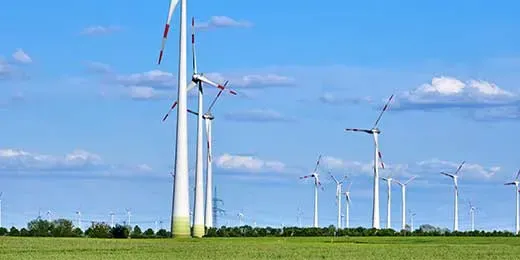Hyundai Motorstudio Senayan Park
Hyundai Motorstudio Senayan Park
Newsroom
The official news from Hyundai Motorstudio Senayan Park and a collection of innovative articles on mobility and sustainability here.
-
Wind Energy: Renewable Alternative Energy Source
- Hyundai Motorstudio Senayan Park Senayan Park 2022.05.25
-
It is estimated that humans have known about wind energy since 1,300 years ago. In the past, wind power was used for various purposes. Such as irrigating plantations, drying wet land, driving wheels for factory equipment, and much more.Along with the development of technology, now wind energy is also still used to drive turbine generators as electricity generators. Then. How does wind energy work to produce electricity? And, is it true that wind energy will become a renewable alternative energy source in the future? To reveal the answer, find out the following discussion!
How wind energy works
Maybe you are wondering, how does the mechanism or system of wind energy work? Basically, how a wind turbine works is quite simple.Wind turbines use wind to generate electricity. First, the wind will spin giant vanes around the rotor, which will then turn the turbine generator to generate electricity.However, so that the windmill can generate electricity optimally. Of course, it needs to be supported in various aspects. One of them is that the location of the wind turbine must be strategic.
Wind is a form of solar energy that is influenced by three factors, including:- The irregular shape of the earth's surface.
- Earth Rotation.
- Uneven heating of the atmosphere by the sun.
The terms wind energy or wind power both describe the process by which wind is used to produce mechanical power or electrical power. The mechanical power can be used for certain tasks. Such as grinding grain, pumping water, or driving a turbine generator. Thus, the mechanical energy is converted into electrical power.Wind turbines convert wind energy into electricity with the aerodynamic force of giant propellers. As wind flows across the blades, the air pressure on one side of the blades decreases.This difference in air pressure creates lift and drag. The lifting force is stronger than the tensile force, which is why the rotor in the turbine rotates. The stronger the wind blows, the faster the rotation and allows the generator to produce large amounts of electricity.But, how much electricity needs can be met by wind energy?
It should be noted in advance that wind energy actually contributes 5-7% of the world's electricity supply. If calculated globally, wind energy capacity exceeds 650 Gigawatts.Nearly 66% of the 650 Gigawatts, provided by wind farms in five countries. Namely, the United States, India, Germany, Spain, and China. Over the past few decades, wind energy capacity in the United States has tripled.Now, even wind energy is becoming the dominant alternative renewable energy source. With wind turbines that can produce more than 100 million watts, wind energy is able to provide electricity to around 29 million households. Amazingly, in terms of cost, wind energy is relatively cheap, almost equal to solar power and natural gas.How big is a wind turbine and how much electricity can it generate?
The wind turbine will be placed on a plot of land about 250 feet or 76 meters high. And, with an average capacity of 2.55 megawatts. Each can generate electricity for hundreds of homes.The smaller wind turbines, on the other hand, are often used in distributed systems that generate power for local use rather than being resold to consumers. Average height is about 30 meters or 100 feet, and produces 5-100 kilowatts.Wind energy potential for the future
Renewable alternative energy sources will continue to be an important component recommended by the government for a cleaner, greener and pollution-free environment.Researchers and scientists in the field of wind power are constantly innovating and looking for effective ways to collect energy and distribute it efficiently to society.For example, researchers at MIT (Massachusetts Institute of Technology) developed the Buoyant Airborne Turbine. A turbine designed like a balloon design. Thus, it can fly to altitudes of up to 600 m and can send electricity to storage or grids.In addition, there is the Tunisian startup Tyler Wind which developed the Hummingbird turbine. The turbine is designed to be more environmentally friendly and reduce the rate of bird deaths from crashing into the propeller. This turbine is an innovation that is effective in saving birds and a better alternative renewable wind energy source.What are the potential for future wind energy technologies other than turbines?
In addition to turbines, it is hoped that wind energy technology will continue to develop as a renewable alternative energy source.Currently, researchers and scientists continue to work on developing turbines n air wind, where the components can be airborne with helium gas or use aerodynamics independently to keep flying in the air. This method is considered effective for capturing stronger wind currents.This system is being considered for offshore use. Where, it is often expensive and difficult to install conventional wind turbines in tall towers.Researchers in the future also want to develop alternative renewable energy sources that carry the concept of being in harmony with nature. Trees can generally still withstand the force of strong winds, by moving as a defensive response.
This is what inspired the researchers to create artificial wind harvesting trees. From mechanical energy or tree movement, it is converted into electricity. Thus, it is suitable to be applied in places with airflow coming from all directions, such as urban or residential areas.Adopting alternative renewable energy sources for daily mobility
As we know, exhaust emissions that collect in the atmosphere come from exhaust fumes of petroleum-fueled vehicles. Renewable alternative energy sources can be applied from now on in daily mobility. Namely, using an electric car that is environmentally friendly and pollution-free.Hyundai Motors creates a variety of innovative LGCC (low cost green cars) vehicles that produce 0% carbon dioxide exhaust emissions.




